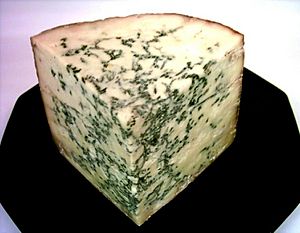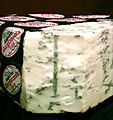Blue cheese facts for kids
Blue cheese is a special kind of cheese that has a type of fungus (like a tiny plant, but not green!) added to it. This fungus is called Penicillium. It's what makes the cheese have those cool blue or green spots and lines inside. Blue cheese can be made from milk from cows, sheep, or even goats.
Some famous types of blue cheese are Roquefort cheese, Stilton cheese, and Gorgonzola cheese. These names are often protected, meaning only cheese made in certain places can use them, like a special club for cheeses!
Contents
What's Inside Blue Cheese?
Blue cheese isn't just tasty; it also has some good stuff for your body! Here's what you might find in about 100 grams (a small block) of blue cheese:
- Energy: Around 353 calories, which gives you fuel for your day.
- Protein: About 21 grams, which is great for building muscles.
- Fats: Around 28 grams, which are important for energy.
- Carbs: Only about 2 grams, so it's not very sugary.
- Vitamin B12: It has a lot of this vitamin, about half of what you need each day! Vitamin B12 helps your body make red blood cells.
How Blue Cheese is Made
Making blue cheese is a bit like making other cheeses, but with a special step that gives it its unique blue look.
First Steps to Cheese
The process starts with six main steps, just like many other cheeses:
- Making it Acidic: First, a special "starter" is added to milk. This changes the milk's acidity, making it turn from a liquid into a soft solid.
- Making it Solid: Next, something called rennet is added. This helps the milk get even more solid, forming thick curds.
- Cutting the Curds: The thick curds are then cut, usually with a knife. This helps release extra liquid, called whey. Smaller cuts mean a harder cheese.
- Adding Salt: Salt is mixed in. This gives the cheese flavor and also helps keep it fresh so it doesn't spoil.
- Shaping the Cheese: The cheese is then put into molds to give it its shape. Sometimes, weights are used to press out more liquid.
- Aging the Cheese: Finally, the cheese is aged in a special room. The temperature and humidity are carefully watched to make sure the cheese tastes and feels just right.
The Blue Secret: Mold and Air
The cool blue streaks in blue cheese come from adding special molds. These molds are usually Penicillium roqueforti or Penicillium glaucum. They are often added after the curds are put into containers to drain and form a cheese wheel.
Today, cheesemakers often use freeze-dried Penicillium roqueforti mold. This means the water has been removed, keeping the mold ready to use. When water is added, the mold "wakes up."
After the mold is added, a very important step is needling. This is when the big wheels of blue cheese are poked with needles. These tiny holes let air get inside the cheese. The air helps the mold grow and spread, creating those famous blue veins all through the cheese!
What Makes it Taste Special?
The strong, unique flavor and smell of blue cheese come from certain natural chemicals. These chemicals are made by the Penicillium roqueforti mold as it grows. They are what give blue cheese its distinctive taste, different from other cheeses.
Images for kids
-
Cambozola, a German variety of blue cheese
-
Gorgonzola cheese
See also
 In Spanish: Queso azul para niños
In Spanish: Queso azul para niños










